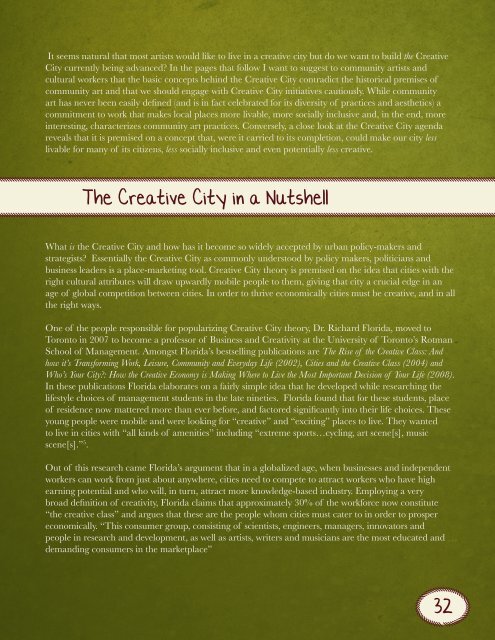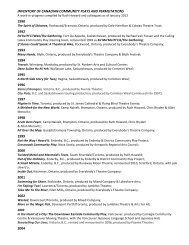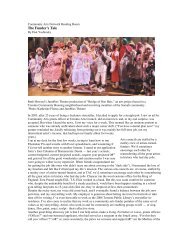publication - Jumblies Theatre
publication - Jumblies Theatre
publication - Jumblies Theatre
- No tags were found...
Create successful ePaper yourself
Turn your PDF publications into a flip-book with our unique Google optimized e-Paper software.
It seems natural that most artists would like to live in a creative city but do we want to build the CreativeCity currently being advanced? In the pages that follow I want to suggest to community artists andcultural workers that the basic concepts behind the Creative City contradict the historical premises ofcommunity art and that we should engage with Creative City initiatives cautiously. While communityart has never been easily defined (and is in fact celebrated for its diversity of practices and aesthetics) acommitment to work that makes local places more livable, more socially inclusive and, in the end, moreinteresting, characterizes community art practices. Conversely, a close look at the Creative City agendareveals that it is premised on a concept that, were it carried to its completion, could make our city lesslivable for many of its citizens, less socially inclusive and even potentially less creative.The Creative City in a NutshellWhat is the Creative City and how has it become so widely accepted by urban policy-makers andstrategists? Essentially the Creative City as commonly understood by policy makers, politicians andbusiness leaders is a place-marketing tool. Creative City theory is premised on the idea that cities with theright cultural attributes will draw upwardly mobile people to them, giving that city a crucial edge in anage of global competition between cities. In order to thrive economically cities must be creative, and in allthe right ways.One of the people responsible for popularizing Creative City theory, Dr. Richard Florida, moved toToronto in 2007 to become a professor of Business and Creativity at the University of Toronto’s RotmanSchool of Management. Amongst Florida’s bestselling <strong>publication</strong>s are The Rise of the Creative Class: Andhow it’s Transforming Work, Leisure, Community and Everyday Life (2002), Cities and the Creative Class (2004) andWho’s Your City?: How the Creative Economy is Making Where to Live the Most Important Decision of Your Life (2008).In these <strong>publication</strong>s Florida elaborates on a fairly simple idea that he developed while researching thelifestyle choices of management students in the late nineties. Florida found that for these students, placeof residence now mattered more than ever before, and factored significantly into their life choices. Theseyoung people were mobile and were looking for “creative” and “exciting” places to live. They wantedto live in cities with “all kinds of amenities” including “extreme sports…cycling, art scene[s], musicscene[s].” 5 .Out of this research came Florida’s argument that in a globalized age, when businesses and independentworkers can work from just about anywhere, cities need to compete to attract workers who have highearning potential and who will, in turn, attract more knowledge-based industry. Employing a verybroad definition of creativity, Florida claims that approximately 30% of the workforce now constitute“the creative class” and argues that these are the people whom cities must cater to in order to prospereconomically. “This consumer group, consisting of scientists, engineers, managers, innovators andpeople in research and development, as well as artists, writers and musicians are the most educated anddemanding consumers in the marketplace”32








